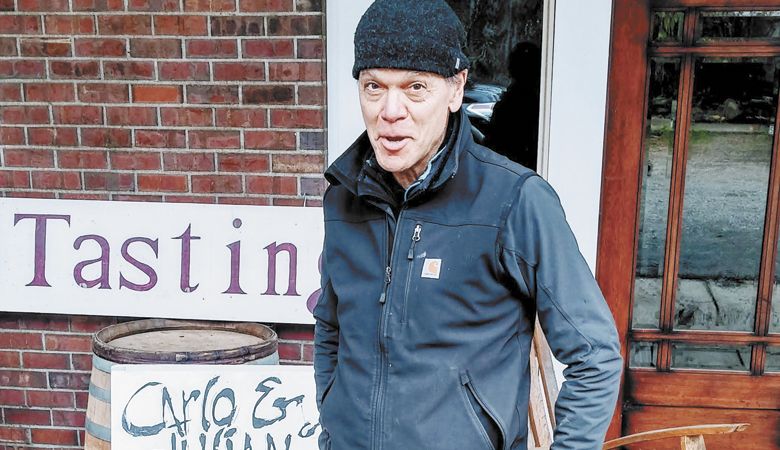Half-Sibling Revelry
Bordeaux-style Blend reveals maligned grape’s Willamette Valley potential
Merlot is so Napa. The grape doesn’t belong in the Willamette Valley, right? Felix Madrid, owner of Carlo & Julian Vineyard & Winery in Carlton, Oregon says, “Guess again.”
Carlton is where farm, industry and community unite to grow, sell and drink Pinot Noir. It is the last place you would expect a Merlot outbreak. Madrid’s new Merlot-Malbec blend might just change that.
Madrid is no neophyte looking to make his name by toppling King Pinot. He came to the Willamette Valley in 1990 when Dick Erath invited him to become a cellar master. Madrid filled his own vineyard in Carlton with Pinot Noir a year later.
After his stint with Erath, Madrid moved on to become REX HILL’S enologist. He eventually struck out on his own to make Carlo & Julian Pinot Noir. The Dick Erath part of Madrid’s Willamette Valley origin story, however, is pure Merlot kismet.
In 1969, Erath planted a small number of Merlot vines on his Dopp Road property in Yamhill County. He would eventually partner with Cal Knudsen to make a Merlot supplemented with a high percentage of Washington state fruit under the Knudsen Erath label.
Growing Merlot in the Willamette Valley wasn’t easy. Erath told interviewers from Linfield University’s “Oregon Wine History Project” that while Merlot should theoretically ripen here, his vines struggled to set fruit. Erath blamed rains during bloom and the numerous underground springs on his property. It turns out own-rooted Merlot vines don’t like wet feet.
Madrid solved this problem when he added Merlot to his vineyard in 1996. He grafted it to the rootstock of Riparia gloire, a wild grape species that does well in damp soils. “It improves the fruit set. It also gives you much riper fruit at the same point in time, compared to own-rooted Merlot or other rootstocks used in the Willamette Valley,” he explained.
Madrid quickly suggests using riparia rootstock is necessary but not sufficient to make great Merlot in the Willamette Valley. “Fruit thinning is critical for getting quality here. I didn’t have to do much thinning in 2020; however, bountiful years require severe thinning to get concentration and intensity in the fruit,” he said.
Until now, Madrid used his Merlot grapes as supporting actors in various blends. This new blend of 65% Merlot and 35% Malbec joins a very exclusive club of wines made primarily with Merlot grapes grown in the Willamette Valley.
How exclusive? I can confirm just one other so far: Myron Redford reports that in 1979 his brother Steve purchased grapes from Jim McDaniel’s vineyard in the Dundee Hills to make a Redford Cellars Merlot.

So why did Madrid not give us the full 100% Merlot monty?
Simply, he likes the way Malbec’s rustic qualities counterpoint the sweetness of his Merlot. Madrid is also drawn to the familial relationship between Merlot and Malbec. “They share a common parent in a grape called Magdeleine Noire des Charentes. This is a good, early ripening combination,” Madrid said. Rarely have half-siblings gotten along this well.
The wine’s color is close enough to Dragonglass to give White Walkers the shivers. Its obsidian shade absorbs all the light in the room. A warning: unless you require hypnotherapy, do not stare into this wine for more than a few minutes at a time.
When you get around to inhaling, this blend struts its stuff with scents of ripe, juicy blackberries. Then it hits with a one-two punch of steaks grilling over red-hot cedar planks. Floating in the background is an herbal note like thyme or rosemary.
Flavors of sweet roadside raspberries and dark plums fill the mouth, along with traces of Assam tea, saline and seared meat fat. It’s also a pleasure to drink a wine where elevated acidity matches up with some serious tannic structure.
Drinking this wine is like driving the Oregon Coast with the windows down to catch the sea breeze and, if I’m lucky, a whiff of that backyard smoker some blond-haired guy in Pacific City keeps fired up all summer. If I’m even luckier, KBDN is playing Waylon Jennings on the radio.
Your tasting results may vary. You might get Travis Tritt.
I first tasted the Merlot that’s in this wine when it was still in barrel. It was achingly beautiful, and I thought to myself, “More people should be planting Merlot in the Willamette Valley.” I haven’t changed my mind after tasting it in Madrid’s final product.
The 2018 Carlo & Julian Merlot-Malbec is not only a bargain at $25 per bottle, it makes a strong case for taking Merlot more seriously in these parts.
The Changeup, a monthly column by Michael Alberty, is a baseball pitch designed to disorient and confuse. It’s the perfect representation of the unknown and its mastery over those who think they know what to expect. This column is devoted to those unorthodox Oregon wines you never saw coming.











